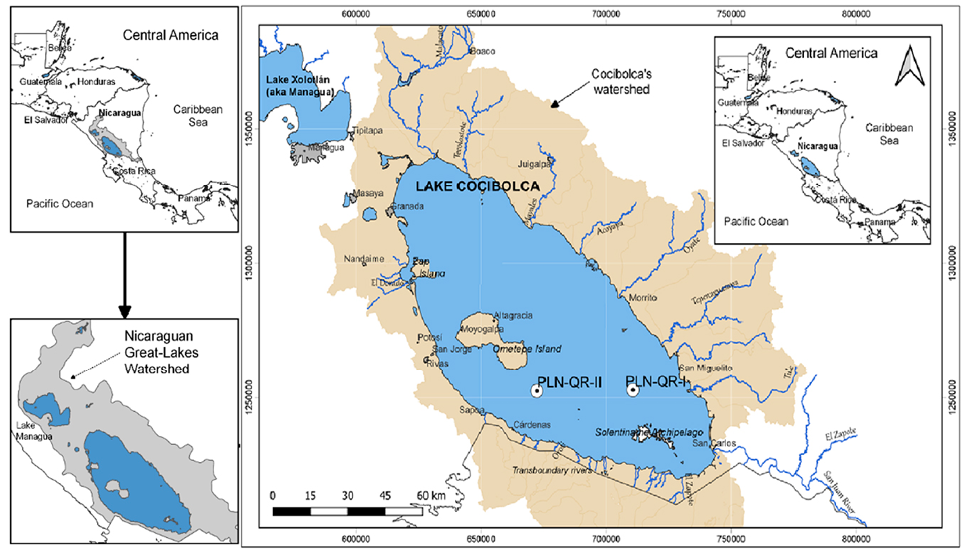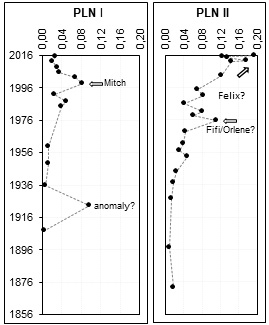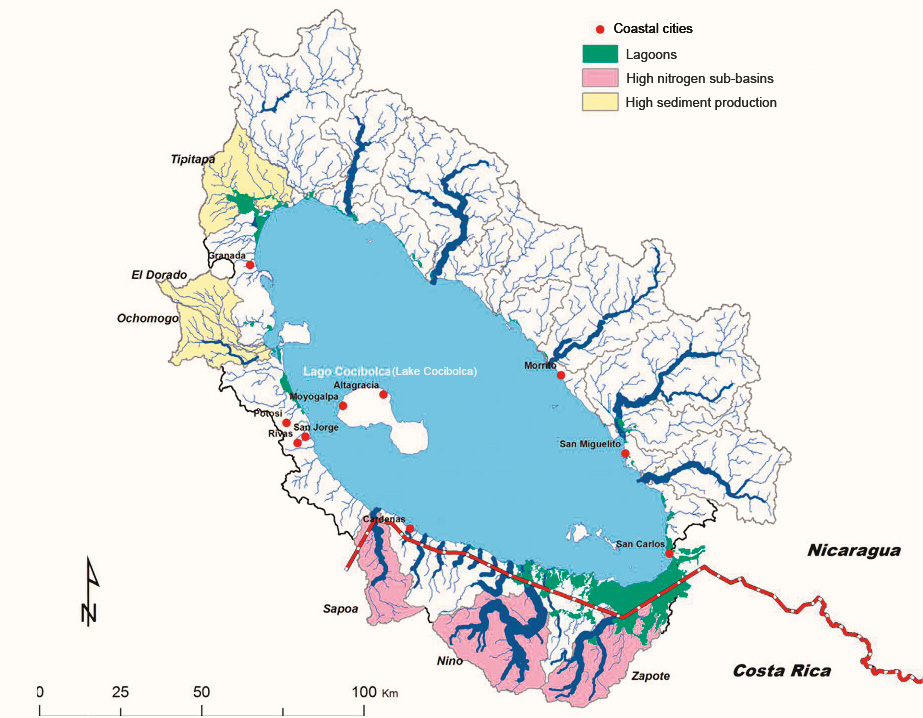ISSN 2410-5708 / e-ISSN 2313-7215
Year 10 | No. 29 | October 2021- January 2022
© Copyright (2021). National Autonomous University of Nicaragua, Managua.
This document is under a Creative Commons
Attribution-NonCommercial-NoDerivs 4.0 International licence.
Knowledge of heterotrophic aquatic biotic organisms (macroinvertebrates) accumulated in the sedimentary layers of Cocibolca lake from the last 100 years.
https://doi.org/10.5377/rtu.v10i29.12742
Submitted on July 16, 2020 / Accepted on June 22, 2021
M.A. Scarleth Margarita Ráudez Reyes
Professor-Researcher
National Autonomous University of Nicaragua, Managua
Center for Aquatic Resources Research of Nicaragua, CIRA
scarleth.raudez@cira.unan.edu.ni
https://orcid.org/0000-0003-4027-3575
M.A. Roberto Antonio Cano Espinoza
Professor-Researcher
National Autonomous University of Nicaragua, Managua
Center for Aquatic Resources Research of Nicaragua, CIRA
https://orcid.org/0000-0001-9658-5987
M.A. Jairo Luis López Palma
Specialist in Laboratory Analysis
National Autonomous University of Nicaragua, Managua
Center for Aquatic Resources Research of Nicaragua, CIRA
Section: Sciences
Scientific Articles
Keywords: paleolimnology, macroinvertebrates, sediments, biological proxies
This study was made possible thanks to the financial support of the Vice Rectorate for Research, Research and Postgraduate Department of UNAN-Managua, through the Research Project Funds, the Center for Aquatic Resources Research of Nicaragua (CIRA/UNAN-Managua), and Queen’s University (PEARL, Kingston, Ontario, Canada).
Abstract
Cocibolca lake is the largest freshwater ecosystem in Central America and has recently gained the attention of the international scientific community due to the planned construction of the interoceanic canal that could potentially cross and impact this system. This study aims to perform a qualitative reconstruction using heterotrophic biological proxies (macroinvertebrates) and their relationship to know extreme natural events, as well as key anthropogenic activities. Through the 210Pb analysis, two high-resolution cores of Cocibolca lake were analyzed, for the last century ~ 100 years, which were collected, one in the eastern zone (PLNI), another near of Ometepe island (PLNII). Relative to the chironomids, a low number of fossils was observed, these conform to the historical limnological records of the lake where this community exhibits low proportions. The high erosion and sedimentation rates, mainly in the southern watershed, provide the system with abundant material rich in nutrients that modify the lake’s productivity. Consequently, the benthic assemblages community have been transformed, favoring opportunistic species that are better adapted to extreme weather events that add to increasing enrichment problems, knotted with the anthropic activities that continue to generate changes and advances in the trophic state on a global scale in Cocibolca Lake.
1. Introduction
Lacustrine sediments are a useful tool for the reconstruction of environmental conditions in certain time intervals because they preserve information on the changes of the environment in the past and their progress in the present. To infer these changes, subfossil macroinvertebrate multi proxies are used, which are related to some physical-chemical factors that help us to explain the historical events found.
The use of fossil remains in environmental research is of great importance due to the prompt response they exhibit when changes occur in the concentration of nutrients, organic matter, and other elements, such as heavy metals to which they were exposed over time, therefore, they are indicators of the trophic state of the environment in which they are found and help us to predict possible changes in climate due to fluctuations in the level of lentic water.
According to Walker (1987), benthic exuviae, mainly fossil remnants of the Family Chironomidae, have been used to track the paleoproductivity of lake systems (Stahl, 1959; Bryce, 1962), to evaluate anthropogenic eutrophication and acidification (Henrikson et al., 1982), to monitor the impact of salinity fluctuations, as well as climatic variations on aquatic communities. In addition, chironomids are sensitive indicators of past temperature and offer great potential to provide independent estimates of regional climatic conditions during transition intervals (Messaferro, J. et al., 2014).
Therefore, it is important to shed light on the macroinvertebrate subfossil groups that make up the sediments of Lake Cocibolca over the last 100 years and relate their presence to past climatic events and watershed activities since they provide a comprehensive and robust understanding of the paleolimnological aspects that occurred spatially and temporally in the lentic system under study.
2. Methodology
Lake Cocibolca (674510E, 1271751.5N, 32 masl) is a shallow, large tectonic lake (8 000 km2, Figure 1) with a hydrological subsystem of almost 24 000 km2 shared with Costa Rica (Montenegro, S. 2003), of which 64% is located in Nicaraguan territory (INETER, 2006) with more than 1.3 million people living there (Ekstrand et al., 2009).
In March 2016, 2 sediment cores (PLNI and PLNII) were collected with the help of the gravity nucleator (UWITEC) at sites: PLN-QR-I (710672 E, 1252821 N), located about 15 km northeast of Mancarron Island in the Solentiname archipelago and PLN-QR-II (672275 E, 1252484 N), collected from the deepest area of the lake over 33 m, 15 km southeast of Maderas volcano.
Cores were visually evaluated, selecting those without signs of sediment mixing, with well-preserved sediment and water phase. The macroinvertebrate fossil records were obtained from the two sedimentary cores (PLNI: 15 cuts and PLNII: 18 cuts) and the analysis of the samples was performed with the methodology suggested by Smol, J. (2001). Fixed plates were made and the fossil organisms were identified with the keys of Messaferro, J. et al., 2014, Cummins, K. 1984. 210Pb dating, sedimentation rate (November 2016-January 2017) were completed at PEARL (Queen’s University, Kingston, Ontario, Canada).
Sediment sections were dated by downhole detector gamma spectrometry (ORTEC gamma counting system) using the Model Supply constant rate (Appleby, P. 1998) and the ScienTissiME package in MatLab® (ScheerSoftware Solutions, Barry’s Bay, ON, Canada). Dates of undated middle sections were interpolated using Excel 2013 and SPSS v.20 via linear regression.

Figure 1.
Location of Lake Cocibolca.
Map compiled with QGIS 3.0.1-Girona, from the cartographic base of the Nicaraguan Institute of Territorial Studies (INETER, 2006). PLN-QRI-I to PLN-QR-II were the coring sites (for more details see in the text “sedimentary coring”).
3. Results and Discussion
Cores ranged on a chronological scale from ~107 (PLNI) to nearly ~144 years (PLNII) of sediment accumulation between 1872 and 2016 (Table 1). For all sites, the minimum sedimentation rate ranged from 0.004 ± 0.005 to 0.014 ± 0.018 g.cm-2.y-1, the sediments accumulated at the PLNI site reflected the lowest value. The PLNII site stands out with the highest sedimentation rates (0.194 ± 0.04 g.cm-2.y-1).
Table 1.
Chronological dating of the PLNI and PLNII sediment cores in Lake Cocibolca.
|
Depth |
PLNI |
PLNII |
Depth |
LNI |
PLNII |
|
0.5 |
2015.0±1.0 |
2015.9±0.2 |
22.5 |
- |
1991.0±2.1 |
|
1.5 |
2012.1±1.3 |
2015.3±0.2 |
23.5 |
- |
*1988.5 |
|
2.5 |
2008.7±1.6 |
2014.5±0.3 |
24.5 |
- |
1986.2±2.2 |
|
3.5 |
2005.3±2.2 |
*2013.9 |
25.5 |
- |
*1984.3 |
|
4.5 |
2002.2±2.7 |
2013.0±0.4 |
26.5 |
- |
1981.0±2.4 |
|
5.5 |
*2000.3 |
2012.2±0.5 |
27.5 |
- |
1979.0±2.5 |
|
6.5 |
1998.4±3.5 |
*2011.7 |
28.5 |
- |
*1977.2 |
|
7.5 |
*1995.2 |
n.d. |
29.5 |
- |
1975.5±2.7 |
|
8.5 |
1991.8±4.9 |
n.d. |
30.5 |
- |
*1974.2 |
|
9.5 |
1987.6±5.8 |
n.d. |
31.5 |
- |
*1971.9 |
|
10.5 |
1984.4±6.5 |
n.d. |
32.5 |
- |
1968.8±2.9 |
|
11.5 |
*1979.6 |
n.d. |
33.5 |
- |
*1965.8 |
|
12.5 |
n.d. |
n.d. |
34.5 |
- |
1961.7±3.2 |
|
13.5 |
*1966.5 |
n.d. |
35.5 |
- |
1957.4±3.5 |
|
14.5 |
1959.5±10.4 |
2003.5±1.5 |
36.5 |
- |
1953.3±3.8 |
|
15.5 |
1949.1±13.4 |
n.d. |
37.5 |
- |
*1948.0 |
|
16.5 |
1935.6±19.2 |
n.d. |
38.5 |
- |
1944.4±4.3 |
|
17.5 |
1923.1±23.1 |
n.d. |
39.5 |
- |
1937.5±4.9 |
|
18.5 |
1908.2±29.8 |
n.d. |
40.5 |
- |
1927.5±6.2 |
|
19.5 |
- |
*1995.9 |
41.5 |
- |
*1913.6 |
|
20.5 |
- |
1994.6±2.0 |
42.5 |
- |
1897.3±13.0 |
|
21.5 |
- |
*1992.4 |
43.5 |
- |
1872.2±27.1 |
Depth: Midpoint depth (en cm); n.d .: No date ; *: Interpolated dates
From ~1900 to the mid-20th century, the sedimentation rate at both sites remained relatively stable below 0.04 g.cm-2.y-1 (Figure 2), except for an unidentified event recorded by PLNI c. 1920. The elevated peaks in some sedimentary layers for both cores appear to be related to the occurrence of strong hydrological events such as hurricanes Fifi/Orlene/Felix in PLNII, and Mitch traced both in PLNI. From a spatial perspective, the sedimentation rate was higher in the southeastern areas (PLNII) than in the eastern part of the lake (PLNI).

Figure 2.
Lake Cocibolca sedimentation velocity profiles.
Presented by extraction site and by year. Units in g.cm-2.y-1. Arrows indicate peaks in sedimentation velocity, presumably related to extreme natural events (e.g., hurricanes). Source: ~100-year sedimentary record of changes in primary production in Lake Cocibolca (Nicaragua).
It is estimated that the largest contributions of sediment deposited in the lake are in the southeastern zone, coming from the Costa Rican basin, followed by the Tule sub-basin in Nicaragua; but the sub-basins that contribute the most nutrients to the lake in order of nutrient contribution are: For phosphorus, the Niño, Ochomogo, Tule, Zapote, Sapoá, and El Dorado sub-basins; and those contributing the most nitrogen are El Dorado, Tipitapa and Ochomogo in Nicaragua, followed by Niño in Costa Rica (Figure 3). These inputs of sediment and nutrients have catalyzed accelerated changes in the trophic state of Lake Cocibolca, and thus in its community structure over a short period in the last century.

Figure 3.
Behavior of the climatological phenomenon del niño (red) and la niña (blue), for the last 150 years. Registro de la NOAA & Autralian BM (2017)
According to studies compiled by the World Bank 2013, the sedimentation rate in the Lake Cocibolca basin is estimated at an average annual rate of 13.3 metric tons per hectare (mt/ha). This sediment load is high when compared to watersheds with well-known sedimentation problems, such as Lake Victoria, which is ten times the size of the Lake Cocibolca watershed, but with similar elevation, rainfall patterns, and deforestation problems.
Eutrophication of aquatic ecosystems is increasing worldwide due to anthropogenic pressures related to nutrient inputs from agriculture, livestock, urbanization, and industry. This scenario is not alien to the lake basin, historically this process has accelerated the enrichment of the lake, giving its origins with the agrarian reform, this activity catalyzed the advance of the agricultural frontier, extensive cattle ranching, extensive monocultures, deforestation, soil erosion, growth of population settlements ~750,000 inhabitants in the coastal areas in 10 localities, according to the last population census of 2008, estimating a contribution of 133-177 tons/year of nitrogen and 26-38 tons/year of total phosphorus (Figure 4). All these activities are often accompanied by structural changes in the food webs as well as in the community structure of zooplankton, phytoplankton, and macrophyte assemblages (Tallberg, P. et al., 1999).

Figure 4.
Sediment and nutrient pollution from coastal populations of Lake Cocibolca.
Note: The thickness of the watercourses represents the magnitude of the sediment load that flows into the lake (the thicker the line, the greater the sediment load). Source: Own estimates based on SWAT simulations (for runoff and soil erosion) and other calculations (from other sources). Source: International Bank. 2013.
The cephalic capsules of macroinvertebrate subfossils (chironomids, Ostracoda, and mollusks) present in cores I and II for the period dated: 1856-2015 were scarce, but appropriately preserved. In core I 8 taxa were found, of which 3 are chironomids (Chironomus sp, Coleotanypus sp, and Cladotanytarsus sp), one taxon corresponds to Chaoborus sp, 2 belong to the Ostracoda group (Darwinula stevensoni and Cypria sp), and 2 specimens to mollusks: Melanoides tuberculata and Pyrgophorus sp.
In core I the highest number of subfossils was found concerning core II (5-6 cm cut: S=4). However, in core II a total of 5 specimens were found corresponding to Chironomus sp, Coleotanypus sp, Cladotanytarsus sp, Chaoborus sp, and Darwinula stevensoni. The strata that housed the highest number of taxa in this core (II) were: 14-15 cm (year 2004), 29-30 cm (year 1978), 34-35 cm (year 1969), and 38-39 cm (year 1956). However, among these sections, no more than 2 taxa were identified. The most frequent taxa in the lake sediments of core lake I and II were Cladotanytarsus sp and Coleotanypus sp respectively.
One of the most important findings of this research was to reveal that these genera inhabit the Cocibolca sediments since 1952 (Cladotanytarsus sp) and 1969 (Coleotanypus sp), according to dating analyses conducted in parallel to this study. Other taxa such as Chironomus sp were recorded for the first time in 1956 in the deep zones of the lake together with the Ostracoda Darwinula stevensoni. However, the oldest record corresponds to Chaoborus sp, the only specimen found in the strata in 1856. Notably, chironomids and ostracods are the diverse and resistant groups among the sedimentary layers of the lake system.
It is also noteworthy that in the dated years corresponding to 2012, 1999, and 1998 no benthic subfossils were observed in the sedimentary layers of core I, similarly, the same behavior is observed for core II in the years 2015, 2014, 2013, 2012, and 1998. Due to the low number of chironomids cephalic capsules present in the different strata sampled from Lake Cocibolca, it is noted that this record does not meet the selection criteria required to determine zonation or statistical analysis so that, the reported findings will not have a robust treatment, but they are the first dated information base made in this system and reveals pioneering chronological information on benthic chironomids exuviae in the different sedimentary strata of Lake Cocibolca.
Other researchers report similar results, such as those published by Wu et al., (2016), who reports low numbers of chironomids cephalic capsules (average <1.6 heads/ml) between ~1220 and 840 cal. yr BP (~ 730-1110 CE), in zone LZ-2 and LZ-3 in the sediments of the Zoncho lagoon of Costa Rica, their records were also poor in zone LZ-1 of the studied system where they report between 9 and 16 taxa. Coincident with this study, it is also mentioned that their results also did not meet the selection criteria required for statistical analysis at some sampling sites, given that the reconstructions are based on subfossil chironomid assemblages that have >95% of subfossils present in the calibration set and are considered reliable (Birks, 1998 cited by Wu, J et al., 2016).
4. Conclusions
•The macroinvertebrate subfossil community (chironomids and ostracods) of Lake Cocibolca dated for the years 1852- 2015 reveals a very poor and undiverse community structure. It seems to indicate that the lack of rooted vegetation around the lake, the continuous contribution of sedimentary material to the lake system, the granulometry of the substrates, interspecific relationships (predation), agricultural activities since ancient times have harmed the low number of taxa recorded and on the diversity of the lentic system.
•The small amount of data obtained in this study prevents us from making decisive conclusions about the nature of environmental change in Lake Cocibolca through the subfossils of chironomids and ostracods, since these data do not meet the criteria for statistical and stratigraphic analysis (zonation) of the proxy communities of the lake system, but are the basis for new research describing the findings of the past, in the last 100 years.
•The low abundance of benthic littoral species is associated with changes in the hydrodynamics of the lake, mainly the oscillating lake levels that have altered the specific niches for these species. Resulting from extreme weather events for this geographic area.
5. Acknowledgments
This study was made possible thanks to the financial support of the Vice Rectorate for Research, Research and Postgraduate Department of UNAN-Managua, through the Research Project Funds, the Center for Aquatic Resources Research of Nicaragua (CIRA/UNAN-Managua), and Queen’s University (PEARL, Kingston, Ontario, Canada).
References
Appleby, P. (1998). Dating recent sediment by 210Pb: problems and solutions. Stuk A-145, 7–24.
Cummins K. (1984). An Introduction to the Aquatic Insects of North America. 702 pages. Second Edition. ISBN 0-8403-3180-0. USA.
Ekstrand, S. et al., (2009). Twinning Europe and Latin-American river basins for research enabling sustainable water resources management (TWINLATIN).
Henrikson, L. et al., (1982), The impact of acidification on Chironomidae (Diptera) as indicated by subfossil stratification. Hydrobiologia 86, 223–229. https://doi.org/10.1007/BF00006140.
International Bank (2013). Prioridades de Política e Inversión Para Reducir la Degradación Ambiental de la Cuenca del Lago de Nicaragua (Cocibolca). 1818 H Street NW Washington DC 20433. Pages 118.
INETER (2006). Cartographic database of the pacific of Nicaragua, scale 1:50000, 3rd Ed. (National basin and sub-basin shapefiles, and also topographic sheet 2951-1).
Messaferro, J. et al., 2014. Paleobioindicadores del fin del mundo: Ostrácodos y quironómidos del extremo sur de Sudamérica en ambientes lacustres cuaternarios. Latin American Journal of Sedimentology and basin analysis. Vol. 21 (2), 97 – 117.
Messaferro, J et al., 2014. Paleogeography, Palaeoclimatology, Palaeoecology. Quantifying climate change in Huelmo mire (Chile, Northwestern Patagonia) during the last glacial termination using a newly developed chironomid-based temperature model. Elsevier. Vol. 399, pages 214-224.
Montenegro, S. (2003). Lake Cocibolca / Nicaragua. In World Lake Basin Management Initiative (p. 29). Saint Michael’s College, Vermont: The Regional Workshop for Europe, Central Asia & the Americas, LAKENET.
NOAA (2017). Historical hurricane tracker tool. Retrieved June 1, 2017, from http://origin.cpc.ncep.noaa.gov/products/analysis_monitoring/ensostuff/ONI_v5.php, accessed in 2016/2017
Smol, J. (2001). Tracking Environmental change using lake sediments. Volume 4: Zoological Indicators.
Tallberg, P et al., 1999. Seasonal succession of phytoplankton and zooplankton along a trophic gradient in a eutrophic lake – implications for food web management. Hydrobiologia 412, 81-94. http://doi.org/10.1023/A:1003804417039
Wu, J. et al., (2016). Chironomid-based reconstruction of late-Holocene climate and environmental change for southern Pacific Costa Rica. The Holocene 1–12. Reprints and permissions: sagepub.co.uk/journalsPermissions.nav. DOI: 10.1177/0959683616652702. hol.sagepub.com